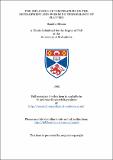The influence of temperature on the development and swimming performance of flatfish
Abstract
Growth and development were studied in turbot {Scophthalmus maximus L.) reared at 12° and 16° until 26 days after hatching. Muscle growth occurred by fibre hypertrophy and hyperplasia and was faster at 16°. In larvae, the sequence of organogenesis was altered by temperature. The influence of temperature on the swimming performance of settled stages of turbot and plaice (Pleuronectes platessa) was studied. Maximum swimming speed (Umax), elicited following an escape response, scaled similarly between 13 and 23°, for turbot, and could be fitted by the model: A comparison of Umax between wild caught and laboratory reared turbot showed that Umax for farmed turbot was lower than for wild fish filmed within 2 weeks of capture. 3 months after capture the average differences in escape performance were no longer significant, suggesting they were due to an acclimation. Standardised Umax for eighteen wild juvenile turbot was determined at 18° and over a temperature change. Repeatability of ranking of the experimental Umax of individuals was maintained over a 6 week period, and through temperature change. For plaice Umax scaled in proportion to TL0.65 between 5° and 13°. Umax did not increase at temperatures above 9°. There was no difference in Umax or tail beat frequency (f) between laboratory reared and wild caught plaice. Umax and f decreased after an acute temperature reduction from 9° to 5° and showed no compensation for the reduction temperature after a 29 days acclimation period. Stride length (X) was independent of temperature. After the 29 day period at 5°, raising the temperature to 9° resulted in an increase in Umax without a corresponding increase in f, although tail beat amplitude (A) was higher. The effects of temperature change during early development on locomotory performance and phenotype are discussed.
Type
Thesis, PhD Doctor of Philosophy
Collections
Items in the St Andrews Research Repository are protected by copyright, with all rights reserved, unless otherwise indicated.

